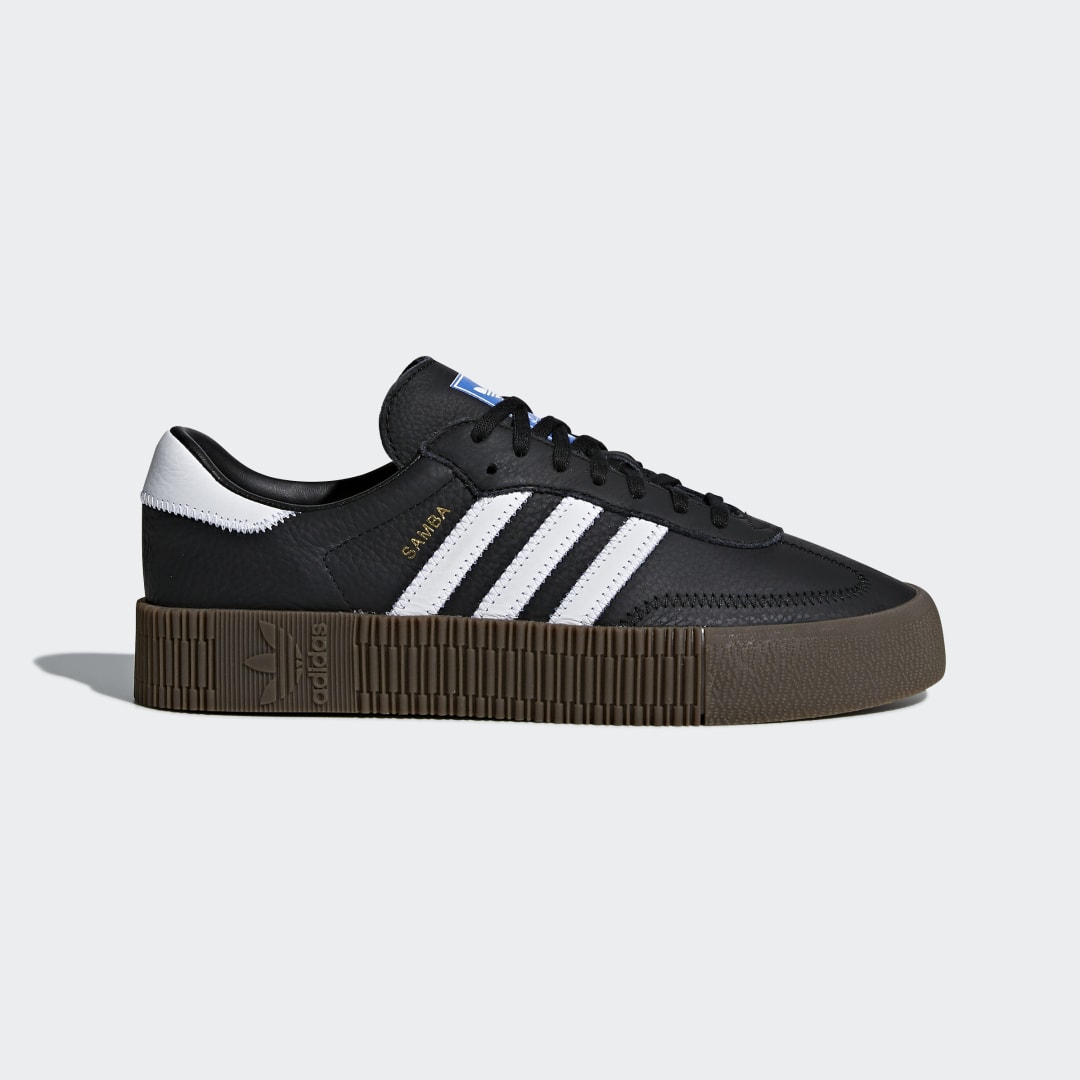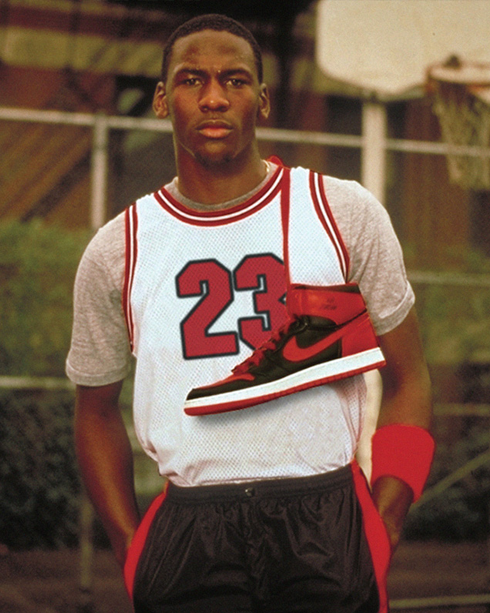adidas
Samba
A culturally impactful sneaker founded on constant reinvention.

An innovative football boot
Way back in 1949, a cobbler by the name of Adolf Dassler was putting the finishing touches on a groundbreaking new football boot. He had built its outsole to offer traction in icy conditions – something which no other shoe of the time was capable of – and began testing it out in his native Germany. The design worked well, and was put into production. Its name was the adidas Samba. Over the course of the next seven decades, this inventive shoe became a cultural phenomenon worn by celebrities, sports stars and just about everyone else on the planet.
An inventive designer
Adolf Dassler was more than a simple shoemaker; he was an inventor. To him, shoe design was more of a hobby than a job, and throughout the 1920s and 30s, he developed his skills by experimenting with different materials and methods for making functional footwear. He was particularly adept at creating athletic shoes, as proven by those he made for Jesse Owens ahead of his multiple appearances at the 1936 Olympics in Berlin. With Dassler’s handmade spikes on his feet, Owens won four gold medals, making a name for both himself and the designer of his shoes.
Establishing a brand
A little over ten years later, in 1949, Dassler formed adidas after splitting from the footwear company he had been running with his brother Rudolf since 1924. Setting out on his own, Adolf began working on projects that could distinguish his designs from those of his brother, who had also established his own shoe company. One of these was a football boot with a black kangaroo leather upper, a gum sole and the brand’s new logo, which consisted of three slanted stripes with serrated edges. It was crafted for one specific purpose: gripping hard, ice-covered pitches. A trio of suction cups incorporated into the outsole were what allowed it to hold onto the slippery ground better than any other shoe of the era, and it was soon shown to be an effective design when put to the test by ASV Herzogenaurach – a local football team associated with the adidas brand.
Finding a name
By 1950, Dassler had perfected the grippy shoe but was yet to find it a name. Then, after a game in which the specialised outsole really came into its own by helping the players to maintain grip and stability despite the frigid conditions, he was struck with an idea to call it the Samba. Not only did this evoke the dynamic movement and skill associated with the lively Brazilian dance form, but it also suited the location of that year’s Fifa World Cup; the first one to be held in the country. Unfortunately, the warm weather expected for the tournament, which would be anywhere from around 20°C and upwards, meant that his outsole design would not be needed. Nevertheless, the shoe’s name effectively connected it with the global competition, and it became popular amongst football players in the years that followed, particularly in the United Kingdom and Europe.
Acquiring knowledge
The adidas Samba helped to grow the company’s profile in its early years, but it was Adolf Dassler’s time with the West German national football team that drew the most attention to the brand. Having ingratiated himself with coach Sepp Herberger, he travelled with the team during games, learning about the players’ needs so that he could provide them with the best footwear for the sport. He watched matches alongside Herberger, and players would come to consult him on the sidelines when they had issues with their shoes so that he could adjust them there and then. Throughout this time, Dassler gained invaluable knowledge which informed an updated footballing model with screw-in studs that could be switched out to suit the conditions of each particular match.
The Miracle of Bern
In 1954, Dassler’s design helped the West German team to a famous World Cup victory known as The Miracle of Bern. Having not been eligible to play in the 1950 tournament, the West German team were desperate to make a good account of themselves in the subsequent one, which was being held in the neighbouring country of Switzerland. After coming through the group stages, they defeated Yugoslavia in the quarter-finals and dispatched Austria 6-1 in the semi-finals to set up a final with tournament favourites Hungary. Known as The Golden Team, the formidable Hungarian squad was unbeaten in 32 matches and had easily overcome the West German side 8-3 during the first round of the competition, albeit against a team of reserves. On the day of the final, rain began to fall, making the pitch wet and muddy. Not only were these the perfect conditions for the playing style of captain Fritz Walter, they were also ideal for Dassler’s interchangeable studs, which provided the German team with a significant advantage by allowing them to adapt to the difficult conditions. Despite being made up of amateurs and given no hope of winning, West Germany emerged victorious, beating the Hungarians 3-2 to pull off one of the greatest upsets in the history of the World Cup and win the country’s first Jules Rimet Trophy.
Functional updates
Adolf Dassler’s company garnered serious attention in the years that followed, with more and more professional footballers beginning to wear his shoes. This helped the Samba to remain popular in subsequent decades as Dassler kept returning to the model, which he redesigned again and again, refining its performance abilities each time he did so and taking it on a remarkable journey in the process. In the early 1960s, the shoe was given a lower profile, and the stripes of the sidewall logo were widened, making the company’s trademark symbol more prominent. The low-cut collar was reworked again in 1972, when it was formed into a more pronounced curve that moved with the shape of the ankle. Also reimagined were the elongated tongue, which was shortened to make it more compact, the underfoot padding, which gave greater support along the length of the foot, and the outsole, whose division into three distinct zones provided the wearer with multidirectional grip, thus affording them more manoeuvrability during play. In fact, it was this version’s flatter outsole and more lightweight build that made the Samba perfect for a new sport known as futsal that was sweeping through continental Europe at the time.
The ideal futsal boot
Futsal originated in 1930s Uruguay, where it was developed by a teacher called Juan Carlos Ceriani. He wanted to make football more accessible, particularly for members of his local YMCA, so he came up with an indoor version based largely on the rules of the traditional game, but also incorporating those from basketball, water polo and handball to suit shorter matches and five-a-side teams. While it was originally designed to be played on a basketball court, many other indoor spaces proved to be adequate for the sport, making it easier to organise as games could be held in a wider choice of locations no matter the weather conditions. The sport quickly grew in popularity across the football-loving nations of South America, eventually making its way to western Europe via immigrants who settled in Spain and Portugal throughout the 1970s. As futsal moved into other European countries, its history became intertwined with that of the adidas Samba, whose grippy outsole and lightweight, reactive feel made it ideally suited to the fast-paced nature of the game. Its low-profile leather toe, now with its distinctive T-shaped overlay, also granted the wearer the ability to achieve high levels of close ball control, allowing them to dribble and manoeuvre through tight spaces and rewarding the technical skills of the individual player. At the time, no other shoe supported futsal players on a range of indoor surfaces, so it was the first choice for many until the 1990s, when other brands began producing footwear specifically for the sport.
Becoming a lifestyle sneaker
Around the same time that the Samba was making a name for itself on Europe’s futsal courts, it began its remarkable transition from functional football boot to fashionable lifestyle shoe. This slow change was initiated by the so-called “Casuals”, who were regularly seen on the terraces of English football clubs in the late 70s and 80s. Before attending matches, the members of this subculture would don distinctive “clobber” – designer clothing from European brands like adidas, Lacoste and Fila which they had picked up while following their teams during campaigns in the European Cup and the UEFA Cup. The idea was to look better than rival groups of supporters by picking unique items of clothing, and adidas shoes were a popular choice. As the style diffused out into wider society, the Samba could be seen on the streets of cities such as Liverpool and London, which had some of the most successful European teams of the time.
A Britpop favourite
While the casual subculture was partly responsible for the rise of adidas in the United Kingdom through the 1980s, it was a musical influence that kept it relevant over the following decade, as Britpop swept the land. A quintessentially British cultural movement, this bright, catchy form of music dominated the country in the mid-90s, with rival bands Oasis and Blur leading the way. Having come from the same working-class background as the Casuals, the rebellious Gallagher brothers were often seen on stage sporting adidas shoes like the Samba, and the model quickly became associated with Britpop, making it a favourite amongst fans of the genre.
Hip hop and the skating community
Meanwhile, over in the United States, the Samba had also risen to popularity through a different kind of music: hip hop. By the mid-80s, Run-DMC were seen as one of the best acts in the nation, and they often turned up to shows with adidas trainers on their feet. Although their particular favourite was the Superstar, the band’s 1986 song My Adidas exposed the brand to a more global audience, especially since it led to a landmark endorsement deal between the two. Through this partnership, the Samba eventually found its way into the world of skateboarding as hip hop culture became intertwined with the rebellious sport during the 80s and 90s. Just like football players, skaters need excellent traction and reactive underfoot feel so that they can effectively control the board, making the Samba an excellent skate shoe. They also wanted a certain kind of style that fit in with the skating lifestyle, and Run-DMC’s backing gave them this. Although a skating version of the Samba wasn’t released until 2017, when the Samba ADV came out, adidas created a model known as the Busenitz in 2006 that was specifically aimed at skaters. Named after American boarder, Dennis Busenitz, who was a prominent figure in the sport in the late-90s and beyond, it went against the trend of the time for vulcanised skate shoes as it was based on the Samba, which had a more durable cupsole that provided support for those wanting to skate and perform tricks with heavier impacts, such as ollieing large flights of stairs or grinding rails beside big drops.
Returning to the mainstream
By the 2000s, the adidas Samba had already been on an epic journey through myriad cultures and sports, even making its way onto the big screen when Ewan McGregor wore a burgundy Samba Super in the 1996 movie Trainspotting, but its story did not end there. After a quiet few years, the silhouette returned in the 2010s when adidas took it back to its footballing roots with the Samba Super Battle Pack, which was released in 2014 to celebrate the World Cup returning to Brazil for the first time since 1950. In the same year, the brand honoured the silhouette by using it as the basis for the first ever knitted football boot: the Samba Primeknit. Celebrities such as Kate Moss soon began wearing it as a fashion item once more, and it became a popular member of the adidas Originals range, which honours the brand’s heritage silhouettes. Even after so many years, the Samba’s minimalist aesthetic still made it a versatile shoe that could work with any number of styles, while its deep history captivated those with an interest in sneaker culture. The range of colourways began to expand, and yet more celebrities were pictured in it, including A$AP Rocky, Frank Ocean and Jonah Hill. Meanwhile, adidas partnered with sporting, streetwear and lifestyle brands such as Oyster Holdings and Fiorucci to create inventive new versions of the classic shoe.
An influential partnership
It was collaborations such as these that saw the adidas Samba gain a strong foothold in the world of fashion around the beginning of the 2020s, and before long it had grown into a truly global phenomenon. The catalyst for its meteoric rise was a collection created with English fashion designer Grace Wales Bonner and her self-titled luxury brand. Bonner’s stylish adidas sneakers were inspired by her British-Jamaican heritage and successfully blended the Samba’s retro sporting aesthetic with elements of high fashion via a combination of intricate stitching and classic features, like the foldover tongue, which had appeared on earlier versions of the shoe. The stunning Wales Bonner collaboration has been ongoing for several years now, and each new colourway seems to be more sought after than the ones before it, ensuring that the Samba remains a popular fashion choice among younger generations.
A wide range of designs
Following the first Wales Bonner Sambas, everyone from skater Jason Dill to record producer Pharrell WIlliams, Canadian design studio JJJJound, luxurious vintage apparel producer Sporty & Rich and even Ajax football club wanted in on the silhouette, the last of these working with Bob Marley’s family to pay tribute to the reggae legend. At the same time, adidas diversified the Samba range even further with a selection of alternative models. As well as the Samba OG, which maintained the favoured casual look, and the skating ADV model, there was the Velosamba, which was optimised for cycling, and the Classic, whose long, foldover tongue, lightweight construction and EVA-injected soles made it more adapted to futsal. The bulkier, more street-ready Samba Super remained part of the collection and was joined by the Samba RM, whose sole contained adidas BOOST technology to make it softer and more responsive, and women’s exclusives like the Sambarose, which came with a platform sole.
Modern trends
All of a sudden, the Samba was the lifestyle sneaker of the moment. Fashion icons like Bella Hadid, Kendall Jenner and Kaia Gerber made it part of the growing trend of the ‘clean girl aesthetic’, being photographed wearing the shoe when out in public and appearing in it on their social media accounts. This made the Samba a must-have for their followers and many other young people, while its sporting heritage brought the shoe even more traction on social media, where it was an essential part of the blokecore style. Emerging in the run up to the 2022 World Cup, blokecore was in some ways a throwback to casual subculture and adidas’ footballing history as it involved pairing the Samba with old replica football shirts and Levi’s. Unlike the earlier football movements, though, this one was global, making the Samba a ubiquitous sight in cities all around the world. With the model infiltrating social media platforms from all angles, 2023 was its biggest year to date, particularly after Wales Bonner announced a new ponyskin edition in November, which demonstrated the significant impact that the collaboration has had on the Samba’s prosperity.
Continued success
The adidas Samba’s incredible rise showed no signs of slowing down in 2024, even after the United Kingdom's prime minister, Rishi Sunak, threatened to damage its credibility by wearing it during a now infamous interview. The sneaker continued to appear all over social media sites, with influencers and fashion brands writing whole articles on how to style the iconic silhouette. Adidas honoured the wide variety of Samba variants by bringing back 2009’s Samba Millenium following a collaboration with high-quality American clothing company Adsum at the end of 2023, while also expanding its skating partnerships by working with up-and-coming skateboarder Kader Sylla. The brand then increased its fashion appeal once again when it joined up with multi-brand retailer Dover Street Market and tapped its footballing connections by creating a series of colourways with brand ambassador Lionel Messi.
A master of change
Despite its age, the adidas Samba has maintained its success through more than 70 years of history, arriving in the modern era as one of the most popular sneakers of the 2020s. Its incredible story has taken it from the icy pitches of the European winter to the futsal courts of the 70s and the football terraces of the 80s, through the skating and Britpop scenes of the 90s, all the way to the celebrity culture of the 2010s and the ever-changing fashion trends of the 2020s. The Samba’s clean aesthetic, versatile styling and vintage sporting appeal continue to attract new fans, but it is the silhouette’s remarkable ability to change with the times that is its strongest attribute and the one that will ensure its success no matter what direction the fashion landscape goes in.


